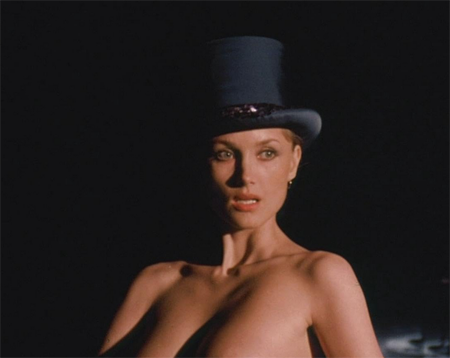
By Lee Pfeiffer
Yul Brynner had such a dynamic and commanding screen presence that he remained a viable leading man long after his boxoffice clout had diminished considerably. Brynner rose to fame and fortune in the mid-1950s with his Oscar-winning performance in "The King and I" as well as his portrayal of the villainous Ramses in Cecil B. DeMille's blockbuster "The Ten Commandments". Many of his high profile films continued to perform well and he proved he could carry stories of a diverse nature including the classic 1960 film "The Magnificent Seven" despite conventional wisdom that he would be a bizarre choice for a leading man in a western. In fact, Brynner managed to avoid being upstaged on screen despite the presence of such up-and-coming major stars as Steve McQueen, Charles Bronson, Robert Vaughn and James Coburn. After that film, Brynner would not enjoy a notable hit until his appearance as a seemingly indestructible and deadly robot in Michael Crichton's 1973 sci-fi film "Westworld". Perhaps a major reason for the film's success is that Brynner was basically recreating the look of his character Chris in "The Magnificent Seven". Brynner worked consistently throughout his career and never lost his status as a leading man. Occasionally, he would make a good film "("Taras Bulba", "Morituri") but more often than not this was not the case. By the late 1970s, Brynner eschewed motion pictures to launch a worldwide touring stage production of "The King and I" with Constance Towers as his leading lady. The show was an international smash and reaffirmed his status as an iconic leading man, as well as filled his coffers with considerable sums. Brynner was diagnosed with terminal cancer during the run of the play, but ever the professional, continued to perform after taking a leave of absence, culminating in the show's triumphant closing run on Broadway. Brynner died in 1985 at age 65.
Yul Brynner's final film was a rather inglorious one, a 1976 Italian crime flick, "Con la rabbia agli occhi", released in 1978 in the U.S. under the unimaginative title "Death Rage". Why? Simply because a few years earlier, director Michael Winner's "Death Wish" proved to be a major international hit, thus studios seemed to insert "Death" in every other film title. In fact, the title seems to be forecasting those films with bland, interchangeable names made by the likes of Jean-Claude Van Damme and Steven Seagal. A UK title (one among several used) was even worse: "Anger in His Eyes". The film was directed by Antonio Margheriti under the name Anthony M. Dawson. The pseudonym caused some fans to believe the film was directed by British actor Anthony Dawson, who famously played the villain Professor Dent in "Dr. No". If all this is confusing, wait until you get to the movie itself. Brynner plays retired hit man Peter Marciani. When we first see him, he's idly fishing on a bank on New York's East River. Given the pollution of the river back in the day, devouring his catch would probably be more dangerous than any assassination mission he ever undertook. A member of the Italian mob approaches him and informs him that he has an opportunity to take revenge on those who killed his brother, a fellow mobster. It seems the same mob boss who killed his brother has also assassinated a lieutenant in their mob. Marciani is offered the job to avenge the killing and, in doing so, taking revenge on the same man responsible for killing his brother. Suffice it to say that Marciani is suitably inspired to fly to Italy where he visits the horse race track where the mobster was killed. Here he meets Angelo (Massimo Ranieri), a young wanna-be mobster who idolizes Manciani based on his legendary reputation in mob circles. Marciani takes the young man under his wing as a henchman. The two escape death and deal out murderous fates to their would-be killers in the quest of killing their ultimate target, Genarre Gallo (Giancarlo Sbragia.) Oh, and along the way, Marciani has a fling with Anny (Barbara Bouchet), a local stripper who emulates Marlene Dietrich on stage, albeit sans any encumbering articles of clothing. Martin Balsam is seen in a rare action role as a Naples police chief who is desperately trying to stop Marciani's trail of murder as he works his way to Gallo.

"Death Rage" is like many other entries in the Italian crime genre of the era in that it is rather crudely made and often looks like it was edited with a meat cleaver. The film also suffers from bad English language dubbing, though Brynner and Balsam retain their real voices. Despite pointing out these criticisms, I actually liked "Death Rage" despite the fact that it borrows heavily from "Death Wish" as well as another Michael Winner crime film of the era, "The Mechanic". Brynner may be in a second-rate thriller but he still gives a first-rate performance as an emotionless killer whose assassination skills are almost supernatural in their effectiveness. Barbara Bouchet is cast mostly as eye candy and to provide a bedroom romp with Brynner. and Massimo Ranieri, who was (and is) a very popular singer in Italy, acquits himself well as Brynner's eager-to-learn student. The movie has some very inventive action sequences including a dazzling car chase through the streets of Naples that clearly scared the hell out of bystanders caught on film.
One would have hoped that Yul Brynner's final movie would have been more prestigious. However, taken on its own, "Death Rage" is actually quite enjoyable.
The film is presently streaming on Amazon Prime.